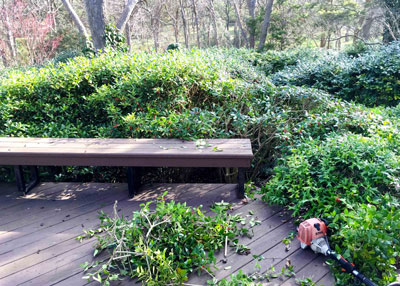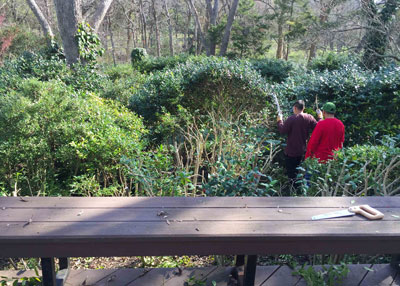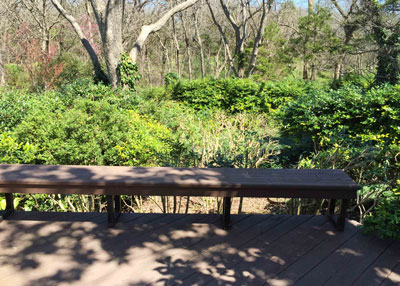Question of the Week: January 12, 2017
“Neil, how far back can I prune my ___, and when should I do it?”
It’s one of the most common questions that I’m asked. In fact, it came up several times in last weekend’s radio programs. Usually it has to do with shrubs, and while there’s no one clear-cut best answer, I’ll give you my general thoughts.

Photo: Needlepoint hollies in the Sperry backyard had, over their 30-plus years, grown taller than the seating on our deck.
• Most shrubs can be pruned by 25 to 30 percent without harm. Winter is usually the best time to do so. Technique, however, will vary species by species.
• If you are having to prune your plants “back” repeatedly, there are good odds that you have the wrong plants in those spaces. It sounds like you might eventually want to replace them with something shorter or more narrow.
• Lopping shears and hand pruners are always better than power hedge trimmers. The hedge trimmers lack all finesse. They can’t distinguish between healthy twigs and dead stubble. All they can do is give a globe or a cube when you’re done. For most plants, that’s not going to be attractive. You want to be able to tailor and sculpt, removing dead or damaged branches in the process. You can only do that with hand tools.
• I try to remove branches down into the plant’s canopy so that other growth will remain in place to conceal the cut ends. I try never to leave stubs. They usually result in a proliferation of vigorous new shoots right at their ends – not a handsome look.
• I force myself to remove one branch at a time. I start with the branch that is most obviously in a place where I don’t want a branch to be. Then I step back to see what results I’ve had. That allows me to decide which branch would be my next one to remove.
• Eventually I end up removing one or two green, active shoots to even up the plant’s growth habit. But I save that until the end of the pruning process.

Photo: This is the harshest pruning I’ve ever given shrubs in our landscape. (So much so that I hired help with the task.) We left foliage on the plants, but not nearly as much as I would normally want. We were only going after the Needlepoint hollies. Nellie R. Stevens hollies that surrounded were not trimmed.
Exceptions to these steps:
I can think of a few places where I don’t follow those guidelines.
• Nandinas are pruned very differently. When a cane grows too tall, I cut it back completely to the ground with my loppers. It will resprout from there, filling the plant in from its base up. I remove about half of the canes (the tallest ones) from my upright nandinas each year. I never cut a nandina stalk anywhere other than clear to the ground. When I’m finished, you can hardly tell they’ve been pruned.
• Dwarf hollies and boxwood. I’m not a big fan of globes, cubes or eggs in my landscape, so I rarely use hedge trimmers. However, one time each year all of my dwarf hollies and boxwoods are trimmed into rounded globes. That’s in mid-February, and from that point on through the growing season I leave them alone to grow on their own. New growth quickly emerges and gives them a soft, light-textured look in my plantings.
• Crape myrtles. I never take anything off the tops of my crape myrtles. If I remove any branch, I remove it entirely, flush with the trunk. That way I never have the ugly knuckles that are so common at this time of year in Texas crape myrtle plantings. People with those crape myrtles would be so much better off cutting their plants to the ground, then allowing them to regrow with many new sprouts so that they could have handsome, normal small trees. Here is pruning information we have posted on the website of our Crape Myrtle Trails of McKinney.

Photo: It was pretty stark out there for a few weeks until new growth started back up, but before that spring was over, the plants were full and beautiful again. This kind of major pruning must be done in the winter.
